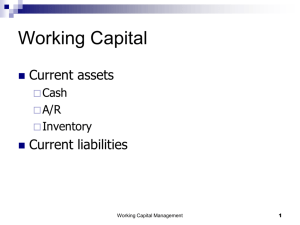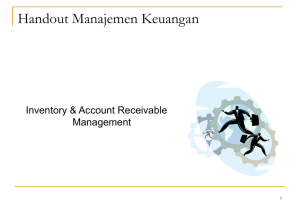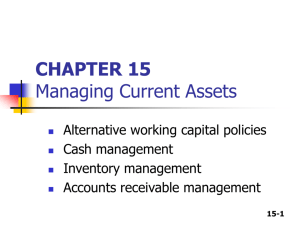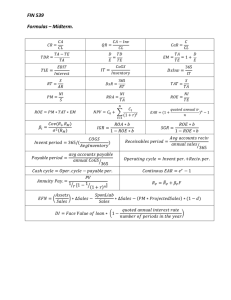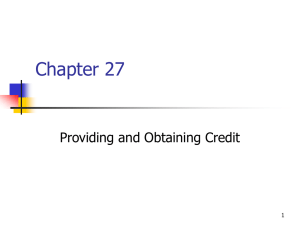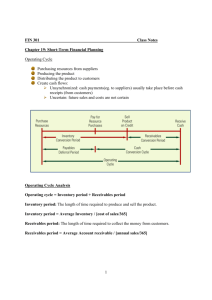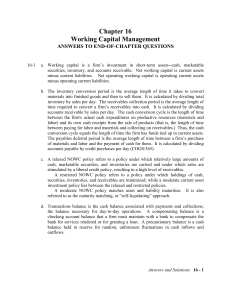BBA - 13 Working Capital
advertisement
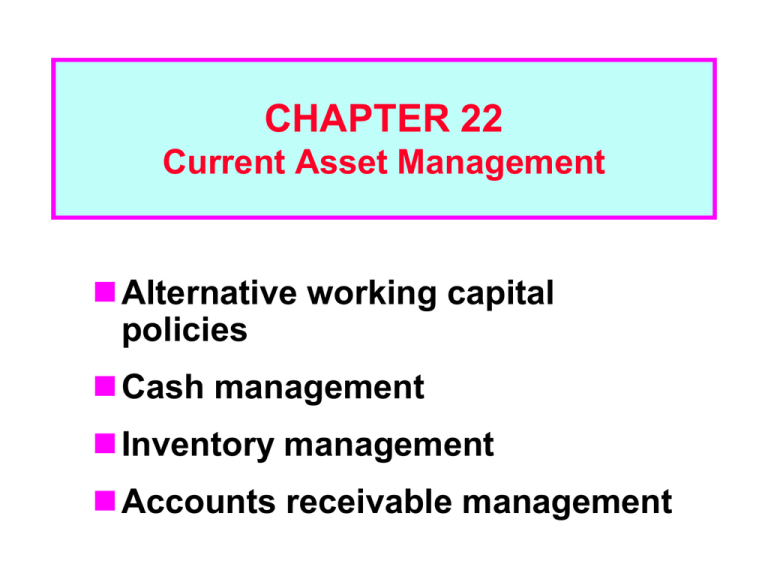
CHAPTER 22 Current Asset Management Alternative working capital policies Cash management Inventory management Accounts receivable management Basic Definitions Gross working capital: Total current assets. Net working capital: Current assets - Current liabilities. Working capital policy: The level of each current asset. How current assets are financed. (More…) Working capital management: Includes both establishing working capital policy and then the day-to-day control of: Cash Inventories Receivables Short-term liabilities Selected Ratios for SKI Incorporated Current Quick Debt/Assets Turnover of cash & securities DSO (days) Inv. turnover F.A. turnover T.A. turnover Profit margin ROE Pay. deferral period SKI 1.75x 0.83x 58.76% Industry 2.25x 1.20x 50.00% 16.67x 45.00 4.82x 11.35x 2.08x 2.07% 10.45% 30.00 22.22x 32.00 7.00x 12.00x 3.00x 3.50% 21.00% 33.00 How does SKI’s working capital policy compare with the industry? Working capital policy is reflected in a firm’s current ratio, quick ratio, turnover of cash and securities, inventory turnover, and DSO. These ratios indicate SKI has large amounts of working capital relative to its level of sales. Thus, SKI is following a relaxed (fat cat) policy. Alternative Current Asset Investment Policies Current Assets ($) Relaxed Moderate Restricted Sales ($) Is SKI inefficient or just conservative? A relaxed policy may be appropriate if it reduces risk more than profitability. However, SKI is much less profitable than the average firm in the industry. This suggests that the company probably has excessive working capital. Cash Conversion Cycle The cash conversion cycle focuses on the time between payments made for materials and labor and payments received from sales: Cash Inventory Receivables Payables conversion = conversion + collection - deferral . cycle period period period Cash Conversion Cycle (Cont.) Payables CCC = Days per year + Days sales – deferral Inv. turnover outstanding period CCC = 360 + 45 – 30 4.82 CCC = 75 + 45 – 30 CCC = 90 days. Cash Conversion Cycle The cash conversion cycle focuses on the time between payments made for materials and labor and payments received from sales: Cash Inventory Receivables Payables conversion = conversion + collection - deferral . cycle period period period What does the cash conversion cycle tell us about working capital management? Cash Management: Cash doesn’t earn interest, so why hold it? Transactions: Must have some cash to pay current bills. Precaution: “Safety stock.” But lessened by credit line and marketable securities. Compensating balances: For loans and/or services provided. Speculation: To take advantage of bargains, to take discounts, and so on. Reduced by credit line, marketable securities. What’s the goal of cash management? To have sufficient cash on hand to meet the needs listed on the previous slide. However, since cash is a non-earning asset, to have not one dollar more. Cash Budget: The Primary Cash Management Tool Purpose: Uses forecasts of cash inflows, outflows, and ending cash balances to predict loan needs and funds available for temporary investment. Timing: Daily, weekly, or monthly, depending upon budget’s purpose. Monthly for annual planning, daily for actual cash management. Data Required for Cash Budget 1. Sales forecast. 2. Information on collections delay. 3. Forecast of purchases and payment terms. 4. Forecast of cash expenses: wages, taxes, utilities, and so on. 5. Initial cash on hand. 6. Target cash balance. SKI’s Cash Budget for January and February Net Cash Flows January February Collections $67,651.95 $62,755.40 Purchases $44,603.75 $36,472.65 Wages 6,690.56 5,470.90 Rent 2,500.00 2,500.00 $53,794.31 $44,443.55 $13,857.64 $18,311.85 Total payments Net CF Cash Budget (Continued) Cash at start Net CF Cumulative cash Less: target cash Surplus January February $ 3,000.00 13,857.64 $16,857.64 1,500.00 $16,857.64 18,311.85 $35,169.49 1,500.00 $15,357.64 $33,669.49 Should depreciation be explicitly included in the cash budget? No. Depreciation is a noncash charge. Only cash payments and receipts appear on cash budget. However, depreciation does affect taxes, which do appear in the cash budget. What are some other potential cash inflows besides collections? Proceeds from fixed asset sales. Proceeds from stock and bond sales. Interest earned. Court settlements. How can interest earned or paid on short-term securities or loans be incorporated in the cash budget? Interest earned: Add line in the collections section. Interest paid: Add line in the payments section. Found as interest rate x surplus/loan line of cash budget for preceding month. Note: Interest on any other debt would need to be incorporated as well. What reasons might SKI have for maintaining a relatively high amount of cash? If sales turn out to be considerably less than expected, SKI could face a cash shortfall. A company may choose to hold large amounts of cash if it does not have much faith in its sales forecast, or if it is very conservative. The cash may be there, in part, to fund a planned fixed asset acquisition. Inventory Management: Categories of Inventory Costs Carrying Costs: Storage and handling costs, insurance, property taxes, depreciation, and obsolescence. Ordering Costs: Cost of placing orders, shipping, and handling costs. Costs of Running Short: Loss of sales, loss of customer goodwill, and the disruption of production schedules. If SKI reduces its inventory, without adversely affecting sales, what effect will this have on its cash position? Short run: Cash will increase as inventory purchases decline. Long run: Company is likely to then take steps to reduce its cash holdings. Elements of Credit Policy Cash Discounts: Lowers price. Attracts new customers and reduces DSO. Credit Period: How long to pay? Shorter period reduces DSO and average A/R, but it may discourage sales. (More…) Credit Standards: Tighter standards reduce bad debt losses, but may reduce sales. Fewer bad debts reduces DSO. Collection Policy: Tougher policy will reduce DSO, but may damage customer relationships. Short-Term Financing Working capital financing policies Accounts payable (trade credit) Commercial paper Short-term bank loans Secured short-term credit Working Capital Financing Policies Maturity Matching: Matches the maturity of the assets with the maturity of the financing. Aggressive: Uses short-term (temporary) capital to finance some permanent assets. Conservative: Uses long-term (permanent) capital to finance some temporary assets. Maturity Matching Financing Policy $ Temp. C.A. S-T Loans Perm C.A. L-T Fin: Stock, Bonds, Spon. C.L. Fixed Assets Years What are “permanent” assets? Aggressive Financing Policy $ Temp. C.A. S-T Loans Perm C.A. L-T Fin: Stock, Bonds, Spon. C.L. Fixed Assets Years More aggressive the lower the dashed line. Conservative Financing Policy $ Marketable Securities Zero S-T debt Perm C.A. Fixed Assets L-T Fin: Stock, Bonds, Spon. C.L. Years The choice of working capital policy is a classic risk/return tradeoff. The aggressive policy promises the highest return but carries the greatest risk. The conservative policy has the least risk but also the lowest expected return. The moderate (maturity matching) policy falls between the two extremes. What is short-term credit? What are the major sources? Short-term credit: Debt requiring repayment within one year. Major sources: Accruals Accounts payable (trade credit) Commercial paper – An unsecured obligation issued by a corporation or bank to finance its short-term credit needs. Maturities typically range from 2 to 270 days. Bank loans Short-term debt is riskier than long-term debt for the borrower. Short-term rates may rise. May have trouble rolling debt over. Advantages of short-term debt. Typically lower cost. Can get funds relatively quickly with low transactions costs. Can repay without penalty. What is trade credit? Trade credit is credit furnished by a firm’s suppliers. Trade credit is often the largest source of short-term credit for small firms. Trade credit is spontaneous and relatively easy to get, but the cost can be high. What is a secured loan? In a secured loan, the borrower pledges assets as collateral for the loan. For short-term loans, the most commonly pledged assets are receivables and inventories. Securities are great collateral, but generally firms needing short-term loans generally do not have securities. What are the differences between pledging and factoring receivables? If receivables are pledged, the lender has recourse against both the original buyer of the goods and the borrower. • Offering assets to a lender as collateral for a loan. When receivables are factored, they are generally sold, and the buyer (lender) has no recourse to the borrower.
